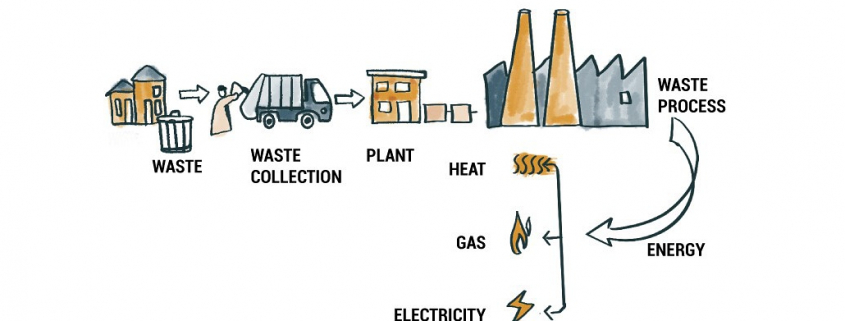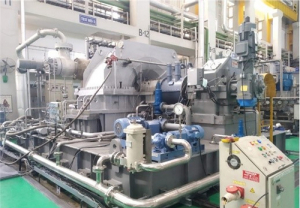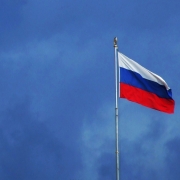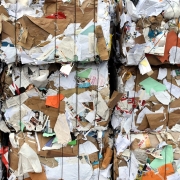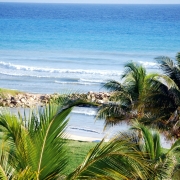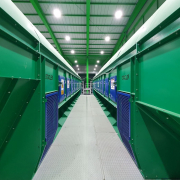Case Study of Triveni Turbine Limited on Sustainable Energy from Waste using RDF Production: First Waste to Energy plant in Germany
With more than 50 years of expertise in the industrial steam turbine business, Triveni’s steam turbine solutions have earned a promising customer, Klingele Papierwerke GmbH & Co. KG, aleading International Paper manufacturer in Germany.
The Steam Turbine Generator (STG) unit was successfully installed and commissioned at Weener, Germany during the month of August 2021 with round the clock support from Triveni’s service engineers, amid COVID pandemic crisis across the globe.
The case study informs how Triveni’s steam turbine has helped Klingele Weener Paper mill to utilize the required heat and the electricity generated by Weener Energie (its own power plant) that runs on refuse-derived fuel (RDF).
Since 2008 Weener Energie has supplied the thermal energy required for paper drying. Weener Energie in turn is fuelled with waste material from its paper mill. RDF is procured locally which in turn reduced the transportation costs and CO2 emissions.
The project is driven by Triveni 15.6MWe steam turbine with an inlet steam pressure of 27 Bar and inlet temperature of 320 Deg C.
Challenge
- Paper production is energy intensive with considerable utilization of thermal energy (heat) for paper drying process and electrical energy. In order to meet the plant’s demand, the client decided to invest in aRefuse-derived fuel (RDF) power plant.
Solution
- Triveni supplied the steam turbine generator unit and other equipment for generating energy to power the paper plant and also the neighboring communities by processing 300,000 tons of waste produced each year.
Benefits
- Approximately 850,000 tonnes of steam is required annually by the paper mill and a significant percent of this is generated by incinerating waste in an eco-friendly way.
- The excess heat from the paper drying process is fed through a district heating pipeline to heat the outdoor swimming pool run by the municipality.
- The RDF power plant saves 32 million cubic meters of natural gas and primary energy through this process thereby reducing CO2 emission from fossil fuels by 55,000 tonnes per year.
To complement the above New Product portfolio, Triveni’s refurbishment arm Triveni REFURB steps up to provide an After Market solution for the complete range of rotating equipment across the globe. From steam turbines, compressors to the gas turbine range, the company has adapted to ensure that the customer finds a one stop solution.
With rising costs, operating turbines efficiently is a necessity for cost saving and creating a positive carbon footprint
With either change in requirement of the process or age, the turbines become inefficient and impact costs. The team works with the customer to understand the current needs and re-design the turbine to meet the new parameters ensuring the turbine is efficient leading to cost saving
Triveni improves the efficiency of existing turbines across all brands by retaining the existing housing and civil. The internals like rotor, stator, bearings etc are replaced with our highly efficient design and upgraded steam flow path giving the customer the below benefits
- Upto 15% improvement in efficiency
- Upgraded steam flow path
- Re-use existing turbine housing and auxiliaries
- No modification on civil foundation & structures
- Life extension to over 100,000 hours
- ROI under 2 years resulting in increased profitability of operations
The company has successfully commissioned such projects and has delighted customers assisting them in achieving lower OPEX costs.
Case Study-Aftermarket:
A renowned customer was operating their 8MW European OEM Turbine for more than 15 years. The turbine was operating inefficiently due to natural degradation. Triveni reviewed the turbine design and confirmed to customers that they would modify the parameters as per current requirement and also ensure availability of 1 MW of extra power.
Triveni REFURB provided a solution to route the additional steam to the existing Turbine with upgraded steam flow path design.
The overall project cost was significantly lower as there was no modification to the civil foundation and also the Turbine housing was retained. The turbine was commissioned and handed over. With a 1 MW power addition and process stabilization, the pay back is under a year.
Globally, the Power Generation Industry has been witnessing a major transformation in the last few years and this is expected to continue in the coming years as well. This resulted in changing energy generation mix and a transformational shift from conventional sources to renewable sources.
The industry has observed some key trends like sustainable power development; focus towards various concerns related to climate change along with eco-friendly policies. It is largely expected that the industry may witness greater acceleration towards eco-friendly “Green Power” solutions going forward.
Globally, the captive power generation is the key growth enabler for many manufacturing industries, where grid disturbances in supply of power can affect their operations. Owing to the increasing demand for power from emerging industrialized economies such as China, India, Africa and Middle East, the investment in captive power plants is expected to remain strong.
Captive power generation units can be fired using both fossil fuel and renewable. The largest market for captive power generation in the country is the Industrial sector, mainly on account of the increasing demand for electricity from energy-intensive industries such as Cement, Iron & Steel, Petroleum Refineries and Chemicals etc.
Globally, there is an increasing focus on the replacement of existing coal-fired power plants with clean fuel power plants in order to reduce carbon footprint and thiswill further augment the demand for renewable power generation in the future.
Renewables comprise of non-thermal (such as Hydro, Solar and Wind) and thermal energy sources (such as Bio-energy, Waste Heat, Waste-to-Energy, Solar Thermal and Geothermal). For thermal renewable energy, the Bio-energy will remain the prime source. Its share is expected to decline in the future due to the expansion of alternate non-thermal renewable power generation technologies namely Solar, Photovoltaic and Wind.
Rise of the Waste to Energy (WtE) Industry
The first waste-to-energy combustion facility in the U.S. went on line in New York in 1898, according to the Energy Information Administration. About 80 years later, in 1975, the first commercial-scale, utility-grade Municipal Solid Waste (MSW) based power plant went on line in USA. Early 1980s that really were the genesis for this industry at that time when the desire for alternative energy sources and energy prices rose.
Challenges faced by the WtE Industry
Waste-to-energy (WtE) refers to a variety of treatment technologies that convert waste to electricity, heat, fuel or other usable materials, as well as a range of residues.
Waste is a challenging fuel due to its i) heterogeneous nature, ii) low calorific value (6-10 MJ/kg, well below coal at roughly 25 to 30 MJ/kg), iii) high moisture content and potentially harmful emissions. The key is to identify the calorific value (CV) of the waste as it determines the most feasible solution. Determining the CV of the MSW is important to the design and success of any incineration project.In developing countries, the low calorific valueand high moisture content of waste remaincritical technical challenges for thermal WtE. Low calorific value of waste should averageat least 7 MJ/kg, and never fall below 6 MJ/kg.
There are several primary waste streams in urban areas. Municipal Solid Waste (MSW) is one of the primary waste streams that are disposed of in municipal landfills followed by Commercial and Industrial Waste (CIW).
Several alternative methods to landfill of MSW disposal have been developed and are in use, including 1) bio-digestion of the organic components, 2) sorting, recycling and composting of suitable materials, and 3) thermal treatment of waste to reduce the volume.
Opportunities Ahead – Thermal WtE Sector
Thermal WtE utilizes the energy value in waste to generate electricity and/or heat. Thermal WtE can potentially reduce waste sector greenhouse gas emissions compared to open burning and landfills without methane gas capture and use, but will not completely abate greenhouse gas emissions.In Europe alone, Waste-to-energy (WtE) could prevent the production of up to 50 million tons of CO2 emissions that would otherwise be generated by burning fossil fuels.
Thermal WtE requires significant investment for startup, operation and maintenance. Income from waste disposal and energy sales is often insufficient to cover full investment and operational costs.
Thermal treatment of waste is an environmentally acceptable alternative method. The thermal utilization process can be divided into three categories namely a) incineration/combustion, b) gasification and c) production of Refuse Derived Fuel (RDF).
Thermal WtE, also known as incineration with energy recovery, is a major waste treatment method in some developed countries and the most widely adopted technology that dominates the global WtE market. Incineration/Combustion is a process that takes place in an environment with excess air. Gasification is a process of partial oxidation, requiring excess air slightly below the stoichiometric level. RDF production involves separating, sorting, drying and compressing the combustible portion of the waste, resulting in a product which can be used as a feedstock for any of the three thermal processes, or combusted in an industrial application.
Source: Triveni Turbines (Bengaluru, India, March 16, 2022)

